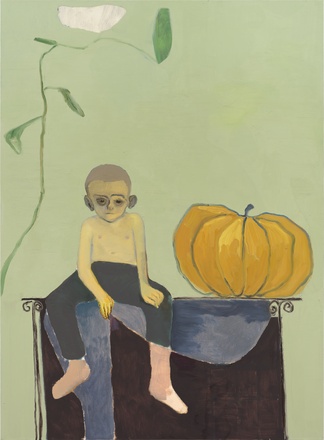Sanya Kantarovsky
Pumpkin II (2022)
Sanya Kantarovsky’s paintings often delve into themes of intimacy and the human experience, capturing a sense of an unfolding crisis. The subjects depicted in his fictional portraits are often portrayed in states of ambivalence, and implied narratives remain unresolved, proposing multiple, often contradictory reads. The artist’s painterly language frequently draws on a wide array of distinct art historical motifs, as well as elements from broader culture such as cinema, literature, design, and illustration.The common traits of Kantarovsky’s work become apparent in “Pumpkin II,” the artist’s first edition for TEXTE ZUR KUNST. The piece pictures a boy sitting next to a pumpkin against a monochromatic, stage-like background that amplifies a dramatic and barren atmosphere. The boy’s gaze is directed at the viewer, yet seems to look past, as if addressing a wider group. His eyes are dramatically different from one another, almost as if they belong to two different individuals, one old and the other young. His face betrays a blank resignation frequently found in archetypal depictions of martyrdom. The composition, previously shown at the artist’s recent solo exhibition at Capitain Petzel in Berlin, is borrowed from an old photograph of Kantarovsky sitting next to a comically large pumpkin grown in his family’s garden.The massive fruit, rendered in a thick impasto palette reminiscent of Vincent van Gogh’s “Sunflowers,” appears as a hopeful yet hollow counterweight to the human subject’s internal world. This simultaneity of gravity and comedy embodies the paradoxical atmosphere that characterizes Kantarovsky’s body of work, in both method and temperament.

